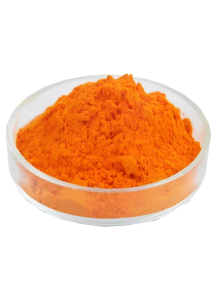Marigold Extract (Zeaxanthin 5% Water Soluble)
a type of carotenoid It is a pigment found in plants that gives yellow, orange and red colors. It is also found in small amounts in the human body concentrated in the eyes and skin.
a type of carotenoid It is a pigment found in plants that gives yellow, orange and red colors. It is also found in small amounts in the human body concentrated in the eyes and skin.
Zeaxanthin is a type of carotenoid, a natural pigment found in plants and microorganisms, known for its potent antioxidant properties. It accumulates in specific human tissues, particularly the eyes and brain, where it is associated with several health benefits supported by scientific research.
Here are some key health benefits of zeaxanthin, along with research citations:
-
Eye Health Protection:
- Macular Pigment Component: Zeaxanthin, along with lutein, is selectively accumulated in the macula of the retina, forming the macular pigment. This pigment acts as a natural filter for high-energy blue light, protecting the delicate photoreceptor cells from light-induced oxidative damage (Research referenced in PMC6770730, Taylor & Francis Online, PMC4706936, Oxidants and Antioxidants in Medical Science pdf).
- Reduced Risk of Age-Related Macular Degeneration (AMD): Numerous studies link higher dietary intake or blood levels of zeaxanthin and lutein with a reduced risk of developing AMD, a leading cause of vision loss in older adults. The landmark Age-Related Eye Disease Study 2 (AREDS2), a large-scale clinical trial funded by the National Eye Institute, found that supplementing the original AREDS formula with 10 mg lutein and 2 mg zeaxanthin (replacing beta-carotene) further reduced the risk of progression to late-stage AMD compared to the original formula containing beta-carotene (Findings reported in AREDS2 Randomized Trial Report No. 4, BrightFocus Foundation, Macular Disease Foundation Australia, IOVS, Retina Associates of Cleveland, Inc.). A 10-year follow-up study confirmed this benefit (Research published in IOVS, article ID 2774812).
- Potential Cataract Prevention: Observational studies suggest that diets rich in zeaxanthin and lutein may lower the risk of developing cataracts (Evidence discussed in WebMD, PMC4706936, PMC6770730). While the AREDS2 trial did not find an overall significant effect on cataract surgery rates from lutein/zeaxanthin supplementation, it did suggest a potential benefit for individuals with the lowest dietary intake of these carotenoids (AREDS2 Randomized Trial Report No. 4).
- Improved Visual Function: Some research indicates that zeaxanthin may enhance visual performance, such as contrast sensitivity, glare recovery, and vision in dim light (Findings discussed in WebMD, Taylor & Francis Online). Supplementation studies, including those focusing on individuals with high electronic screen use, have shown improvements in measures like photo-stress recovery time (Frontiers - NUT 2025.1522302).
-
Cognitive Function Support:
- Brain Accumulation: Zeaxanthin is one of the primary carotenoids found in the human brain, particularly in areas associated with memory and learning (ResearchGate 232230214, PMC8891800). The density of macular pigment in the eye (MPOD) has been shown to correlate with zeaxanthin levels in brain tissue (ResearchGate 232230214, MDPI - 2072-6643/9/11/1246).
- Enhanced Cognitive Performance: Epidemiological studies link higher zeaxanthin levels (from diet or measured in tissue) with better cognitive function in older adults (ResearchGate 232230214, PMC8891800). Randomized controlled trials have shown that supplementation with lutein and zeaxanthin may improve aspects of cognitive function, such as visual memory, learning, spatial memory, reasoning ability, and complex attention in various age groups, including younger adults and those with cognitive complaints (PMC8891800, MDPI - 2072-6643/9/11/1246, ResearchGate 358302746). The proposed mechanisms involve its antioxidant and anti-inflammatory actions within the brain.
-
Skin Health:
- Protection Against Light Damage: Zeaxanthin's antioxidant properties may help protect the skin from damage caused by light, particularly UV radiation (NeuroReserve).
-
General Antioxidant and Anti-inflammatory Effects:
- Cellular Protection: Zeaxanthin effectively neutralizes harmful free radicals (reactive oxygen species), reducing oxidative stress throughout the body. This antioxidant activity is believed to be the basis for many of its health benefits, protecting cells and tissues from damage (PMC6770730, PMC8874683). Research suggests it may also possess anti-inflammatory properties (ResearchGate 232230214, PMC8891800).
Much of the research combines zeaxanthin with lutein, as they often occur together in food and in the body, particularly the eyes. Recommended levels for eye health benefits derived from studies like AREDS2 are typically 10 mg/day for lutein and 2 mg/day for zeaxanthin (WebMD, Macular Disease Foundation Australia).
| Mechanism | - |
| Appearance | - |
| Longevity | - |
| Strength | - |
| Storage | - |
| Shelf Life | - |
| Allergen(s) | - |
| Dosage (Range) | - |
| Recommended Dosage | - |
| Dosage (Per Day) | - |
| Recommended Dosage (Per Day) | - |
| Mix Method | - |
| Heat Resistance | - |
| Stable in pH range | - |
| Solubility | - |
| Product Types | - |
| INCI | - |
Purchase History for
Cart
No products



